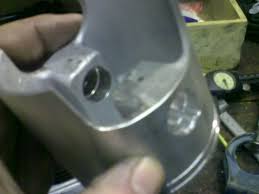PackardV8
Hot Rolled
- Joined
- Jun 4, 2006
- Location
- Spokane, WA
I've been in and around engine shops for fifty years. In the balancing area, some pistons require the removal of a few grams to bring them to target weight. The usual method is to chuck the piston bottom end out in a standard light duty 10" lathe, often having a 4' bed. Sometimes the boss is right at the bottom of the piston; just a facing op.

Sometimes, on older engines with taller pistons having cylindrical skirts, it is necessary to reach in with a boring bar and face off a few thou off the pin bosses. This requires careful hand feeding. Remove, weigh, replace, repeat.

Since the workpiece is never more than 4" long and the working area is never more than 2.5" to 4.5" diameter and 2" deep, a long lathe has way more footprint than the operation requires. The cut taken is always in aluminum and always a light cut. The center of the piston, where the connecting rod small end rides, is always open, so the area being cut is usually less than 1" on each side and usually an interrupted cut.
What other machines and setups could:
1. Have a smaller footprint.
2. Position the piston vertically so the line of sight is more convenient.
3. Be inexpensive enough to not cost more than a light duty lathe.
4. Holding would be "drop in, clamp, cut, open, pull out."
5. Standard tooling
6. Make the cut without hand/eye moving the tooling across the area being cut. Ideally, set the tool, feed down-up or in-out, without having to eyeball the other axis.
I can imagine a small benchtop mill with a variety of flycutters being able to do the work, but to make sure we'd choose the most efficient and cost-effective machine and tooling for this operation, how would you go about replacing the lathe?
jack vines

Sometimes, on older engines with taller pistons having cylindrical skirts, it is necessary to reach in with a boring bar and face off a few thou off the pin bosses. This requires careful hand feeding. Remove, weigh, replace, repeat.
Since the workpiece is never more than 4" long and the working area is never more than 2.5" to 4.5" diameter and 2" deep, a long lathe has way more footprint than the operation requires. The cut taken is always in aluminum and always a light cut. The center of the piston, where the connecting rod small end rides, is always open, so the area being cut is usually less than 1" on each side and usually an interrupted cut.
What other machines and setups could:
1. Have a smaller footprint.
2. Position the piston vertically so the line of sight is more convenient.
3. Be inexpensive enough to not cost more than a light duty lathe.
4. Holding would be "drop in, clamp, cut, open, pull out."
5. Standard tooling
6. Make the cut without hand/eye moving the tooling across the area being cut. Ideally, set the tool, feed down-up or in-out, without having to eyeball the other axis.
I can imagine a small benchtop mill with a variety of flycutters being able to do the work, but to make sure we'd choose the most efficient and cost-effective machine and tooling for this operation, how would you go about replacing the lathe?
jack vines

